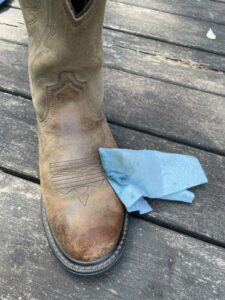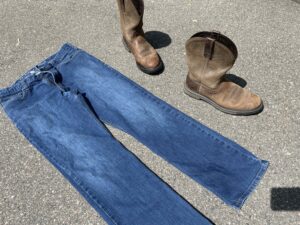You have a few options for keeping ticks off your clothing, and by far the best one is to use permethrin.
I have written before about the power of permethrin for clothing and footwear when it comes to repelling ticks. In fact, the best tick repellent combo I know of is permethrin on clothes, socks, and footwear, and DEET on your exposed skin. I don’t take any chances when it comes to ticks, and this is the combination I use.
In this piece, I want to share a bit more about how to treat your clothing with permethrin.
The Power of Permethrin for Clothes
Permethrin stands out as the gold standard for tick repellency, especially on clothing or other non-skin surfaces. Permethrin works in a swift way, basically making a tick incapacitated on contact. Unlike traditional topical repellents that simply deter ticks from crawling on your skin, permethrin-treated clothing acts as a physical barrier, keeping ticks at bay and drastically reducing the risk of tick bites and the potential transmission of tick-borne illnesses. Think of it like having two lines of defense.
Applying Permethrin to Footwear and Clothing
Here is my step-by-step process of treating clothing and footwear with permethrin.

- First, start with Clean and Dry Fabrics. You need to start with clean materials, so be sure that your footwear and clothing are clean and dry before applying permethrin. This helps maximize the effectiveness of the treatment. If applying on clothing, I usually give it a good wash and dry first, so I am working with completely clean clothing. If you don’t start with clean clothing or footwear, you are really treating the dirt, not the fabric.
- Outdoor or Well-Ventilated Area. This stuff doesn’t really smell at all, and I’ve never had issues with the fumes, but hey, it’s a chemical. Find a suitable outdoor location or a well-ventilated area where you can safely apply the permethrin without inhaling a bunch of it. It is good to find a place that is not in the wind — otherwise, you might lose a lot of the spray to the wind. This stuff is not very heavy.
- Spray or Soak: Permethrin is available in various forms, including sprays and soak solutions. I prefer spray, because I find it much faster to work with and easier to control which parts of the garment are getting treated. Follow the manufacturer’s instructions on the product label for the best application method. If using a spray, apply it evenly to the outer surfaces of your shoes, socks, pants, shirts, and other outdoor garments. If using a soak solution, immerse the clothing completely and agitate gently to ensure thorough coverage. Like I said, I like to spray. Soaking just seems like overkill, plus it allows me to touch-up when I’m out in the field or on the trail.
- Allow Proper Drying Time: After applying permethrin, allow your treated clothing and footwear to dry completely, preferably for at least two hours or as recommended by the product instructions. You might need more time if it is a super humid day. The drying process is very similar to what you would do when treating boots with waterproofing spray.

Apply the permethrin generously - Touch-Up: Even if I have treated me clothing, I often touch-up my boots and lower pantleg often, with just a shot of spray. Why not? If the alternative is potentially getting Lyme disease, I’d much rather use a little extra permethrin and try to be safe.
How Long Does Permethrin Last? How Often Should you Reapply?
You should notice a difference in the amount of ticks you find on you almost immediately after treating your clothes, but it does wear off after a while. How long does this invisible armor last, and when should you consider reinforcing it? Let’s unravel the factors that determine the longevity of permethrin and guide you on the path of optimal protection.
Permethrin, when applied correctly and when you follow the instructions on the can or bottle, adheres to clothing and footwear with remarkable tenacity, offering an extended period of tick repellency. However, several factors influence the duration of its effectiveness and the need for reapplication.
- Product used: The first and most crucial factor to consider is the guidance provided by the manufacturer. Different permethrin products may have specific recommendations regarding reapplication intervals. You are crazy if you don’t carefully read and follow the instructions provided on the product label. These guidelines are tailored to the specific formulation and concentration of permethrin, and it’s application method, ensuring optimal efficacy.
- Environmental Conditions: Exposure to various environmental elements can gradually degrade the effectiveness of permethrin-treated clothing. Factors such as sunlight, heat, humidity, and rain can impact the longevity of the repellent. Intense UV radiation, prolonged exposure to high temperatures, or excessive

I like to wipe the spray into leather, or else it pools. moisture can accelerate the breakdown of permethrin molecules. If you frequently find yourself in harsh environmental conditions or encounter prolonged rainfall, it may be wise to reapply permethrin more frequently.
- Frequency of Use and (especially) Laundering: The more you wear and wash your permethrin-treated garments, the more the repellent’s efficacy may diminish. Regular use and laundering can cause the gradual degradation and loss of permethrin from the fabric. The fact that it can even survive a single washing is pretty great, actually. As a general guideline, it’s advisable to reapply permethrin after approximately six weeks or after six washes, depending on the specific product instructions. However, be sure to refer to the manufacturer’s recommendations for your particular permethrin treatment.
- Intensity of Tick Exposure: The level of tick exposure during your outdoor activities also influences the reapplication frequency of permethrin. If you frequently find yourself in areas known to be heavily infested with ticks or engage in high-risk activities like bushwhacking through dense vegetation, it’s advisable to err on the side of caution and reapply permethrin more frequently. Remember, prevention is key when it comes to tick-borne illnesses. Going through a few extra cans of permethrin is a cheap insurance policy against Lyme disease!
- Personal Preference and Risk Tolerance: Lastly, personal preference and risk tolerance play a role in determining how often you choose to reapply permethrin. Some individuals may opt for more frequent reapplication to maintain a higher level of protection, while others may be comfortable following the manufacturer’s recommended intervals. It’s crucial to strike a balance that aligns with your specific needs and the level of tick exposure you anticipate.
Who Should Consider Using Permethrin
I recommend permethrin-treated clothing to anyone living in tick zones, who spends time outdoors. It is just one of those things you should do, like using sunscreen. Here, in particular, is who should be treating their clothing with permethrin, though.

- Hikers and Campers: With their boots laced up and backpacks slung over their shoulders, hikers and campers are often drawn to the very places where ticks thrive. These outdoor enthusiasts traverse dense forests, tall grasses, and wooded trails, inadvertently crossing paths with ticks along the way. You might reduce the number of ticks by staying on the trail, but even then you can’t totally steer clear of them. The combination of prolonged exposure to tick habitats and close contact with vegetation significantly increases the chances of encountering these persistent creatures.
- Outdoor Recreation Enthusiasts: From avid runners to mountain bikers and nature photographers, outdoor enthusiasts of all kinds can find themselves in tick-prone environments. Activities that involve spending time in grassy or wooded areas heighten the risk of tick encounters. Whether you’re capturing the perfect shot or enjoying an invigorating trail run, it’s essential to be aware of the potential presence of ticks and take appropriate precautions. I especially encourage hunters to treat their clothing, because by nature of what they are doing, they inherently spend lots of time in longer grass where ticks live.
- Residents of Tick-Heavy Zones: Certain regions are known for their dense tick populations and a higher prevalence of tick-borne diseases. If you reside in or frequently visit these areas, you face an increased risk of tick bites. Tick-heavy zones vary across the globe, but they often encompass regions with abundant forests, ample wildlife, and suitable climates for tick survival. Being aware of your local tick activity and taking preventive measures becomes crucial for those living in these areas.
- Professionals Working Outdoors: Foresters, park rangers, landscapers, hunting or fishing guides, and other professionals who spend significant time working in outdoor environments are at an increased risk of tick bites. Their tasks may involve navigating tick-infested areas, managing vegetation, or working in tall grasses and undergrowth, creating ample opportunities for tick encounters. Incorporating tick prevention practices into their routines is vital for their safety and well-being.
- Children and Pets: Children and pets often have a natural inclination to explore the outdoors, making them particularly susceptible to tick bites. Their small size and proximity to the ground increase the likelihood of coming into contact with ticks, and they have a tendency to stray from the beaten path, manicured lawn, or clean patio. They like going where ticks are. Regular tick checks, protective clothing, and tick repellents formulated for children and pets are crucial for safeguarding their health.
Can You Buy Pre-Treated Bug Clothing?
Yes, there are a few manufacturers who sell clothing pre-treated with permethrin. This bug-safe clothing still requires reapplication after many washes, but the application of the permethrin is typically done very thoroughly in the manufacturing process, so you can get lots of wear from the garments before you need to think about reapplying. There are a few pieces we are fans of, especially shirts which have the added benefit of keeping mosquitos away.






